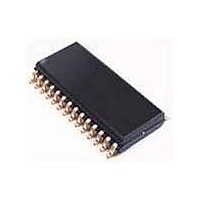PCK2002MPW NXP Semiconductors, PCK2002MPW Datasheet - Page 7

PCK2002MPW
Manufacturer Part Number
PCK2002MPW
Description
Clock Buffer 14.318-167MHZ I2C 1:10CLK BUFR
Manufacturer
NXP Semiconductors
Datasheet
1.PCK2002MPW-T.pdf
(12 pages)
Specifications of PCK2002MPW
Number Of Outputs
10
Max Input Freq
133 MHz
Propagation Delay (max)
2.7 ns
Supply Voltage (max)
3.465 V
Supply Voltage (min)
3.135 V
Maximum Operating Temperature
+ 70 C
Minimum Operating Temperature
0 C
Mounting Style
SMD/SMT
Package / Case
TSSOP-28
Lead Free Status / RoHS Status
Lead free / RoHS Compliant
Other names
PCK2002MPW,112
discouraged and should only be used as a last resort. Stretching the clock/data lines for longer than this time puts the device in an error/time-out
Philips Semiconductors
For example:
A transfer is considered valid after the acknowledge bit corresponding to the byte count is read by the controller. The serial controller interface
can be simplified by discarding the information in both the command code and the byte count bytes and simply reading all the bytes that are
sent to the clock driver after being addressed by the controller. It is expected that the controller will not provide more bytes than the clock driver
can handle. A clock vendor may choose to discard any number of bytes that exceed the defined byte count.
8) Clock stretching: The clock device must not hold/stretch the SCLOCK or SDATA lines low for more than 10 ms. Clock stretching is
mode and may not be supported in all platforms. It is assumed that all data transfers can be completed as specified without the use of
clock/data stretching.
9) General Call: It is assumed that the clock driver will not have to respond to the “general call.”
10) Electrical Characteristics: All electrical characteristics must meet the standard mode specifications found in section 15 of the I
a) Pull-Up Resistors: Any internal resistors pull-ups on the SDATA and SCLOCK inputs must be stated in the individual datasheet. The use of
internal pull-ups on these pins of below 100 k is discouraged. Assume that the board designer will use a single external pull-up resistor for
each line and that these values are in the 5–6 k range. Assume one I
clock driver plus one/two more I
(b) Input Glitch Filters: Only fast mode I
mode device and is not required to support this feature.
11) PWR DWN: If a clock driver is placed in PWR DWN mode, the SDATA and SCLK inputs must be 3-Stated and the device must retain all
programming information. I
For specific I
2001 Jul 19
MSB
0000
0000
0000
0000
0000
0000
0000
0000
0010
Byte count byte
0–300 MHz I
0000 Not allowed. Must have at least one byte.
0001 Data for functional and frequency select register (currently byte 0 in spec)
0010 Reads first two bytes of data. (byte 0 then byte 1)
0100 Reads first four bytes (byte 0, 1, 2, 3 in order)
0101 Reads first five bytes (byte 0, 1, 2, 3, 4 in order)
0000 Max byte count supported = 32
0011 Reads first three bytes (byte 0, 1, 2 in order)
0110 Reads first six bytes (byte 0, 1, 2, 3, 4, 5 in order)
0111 Reads first seven bytes (byte 0, 1, 2, 3, 4, 5, 6 in order)
LSB
2
C information consult the Philips I
2
DD
C 1:10 clock buffer
current due to the I
2
C devices on the platform for capacitive loading purposes.
2
C devices require input glitch filters to suppress bus noise. The clock driver is specified as a standard
2
C Peripherals Data Handbook IC12 (1997) .
2
C circuitry must be characterized and in the data sheet.
2
7
C device per DIMM (serial presence detect), one I
Notes:
PCK2002M
2
C controller, one
2
C specification.
Product data














